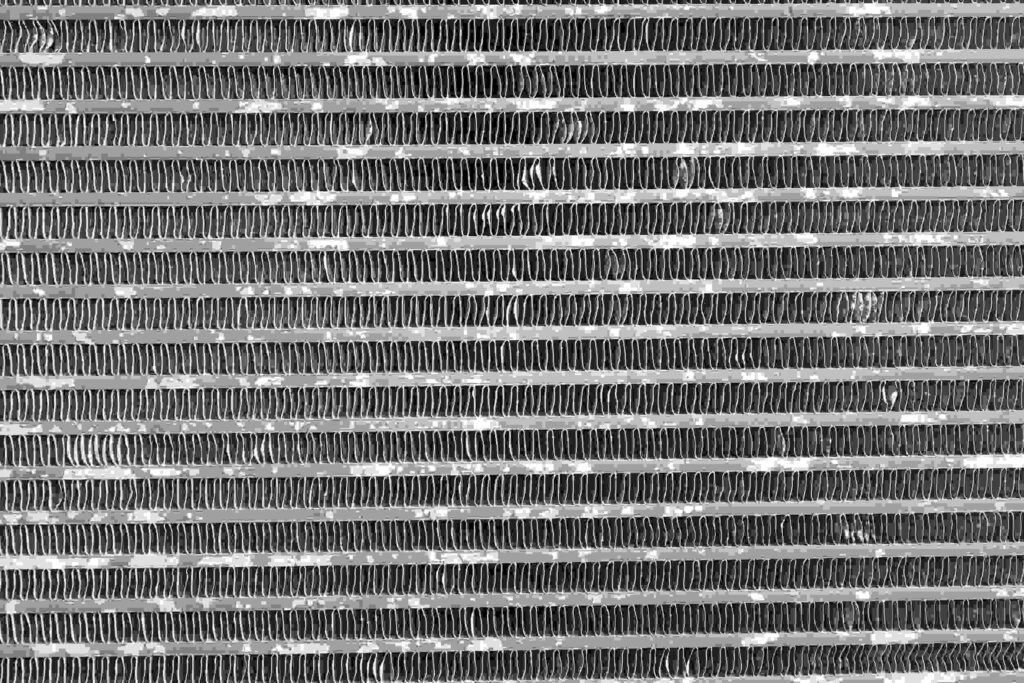The car is overheating, and the only thing you can see that could be wrong is the radiator fins are bent. Not something you’d ever hear someone say has caused their car to overheat. But radiator fins play a vital role in the process of keeping the engine cool.
Something to be aware of before you read on is although bent radiator fins can cause the engine to overheat, it depends on how many are bent or damaged. I’ll explain more about this below.
The Job of the Radiator Core Fins
The thin metal radiator fins are designed to increase the surface area of the radiator core, which means better heat transfer and a greater cooling capacity.
As the hot coolant flows through the tubes of the radiator, the fins do two things: provide a large surface area for the surrounding air to pass through. The other is to absorb the heat from the hot coolant passing through the tubes and release it into the air. Both jobs promote an efficient heat exchange process that cools down the engine and prevents overheating.
How Do Radiator Fins Get Bent?
Radiator fins commonly get bent or damaged from debris like rocks and gravel flicked up by other cars. Of course, something more severe, like a road traffic accident with another vehicle, can also damage the fins, but this would be the least of your worries.
Additionally, the fins deteriorate over time due to exposure to harsh weather conditions, such as extreme heat, corrosive elements, or contaminants getting onto the core. The radiator fins are fragile and don’t take much to bend or break them. So damage can also happen if you or a mechanic do other repairs in the engine bay and accidentally press on the radiator core.
Can Bent Radiator Fins Cause the Car to Overheat?
Yes, bent radiator fins can cause the car to overheat, but it does have to be bad. This is because if the fins are bent, they restrict or completely block the airflow through the radiator core. The coolant cannot be cooled without air passing through the core, and the car will overheat.
You might think the cooling fan should start doing its job now; that’s what it’s there for. However, that is not the case.
While the cooling fan can help prevent overheating when idling or at very low speeds. When you move at high speeds, the coolant is pumping around the engine faster, and there is not enough time to cool the coolant before it is passed back to the engine. That is, if there wasn’t even a blockage to the core caused by bent fins in the first place. The issue is that the cooling fan is effectively fighting against the clogged radiator core. This will cause a rise in working pressure (Pa -Pascals) for the cooling fan. As a result, it will not cool the engine sufficiently.
So you can see why I say the bent radiator fins need to be bad to cause overheating. Providing there is still a good amount of airflow through the radiator, it should still do its job. Pretty much 40 – 50+% of all the fins on a radiator need to be bent to create an airflow blockage large enough to cause an issue. If just a tiny handful, even as much as the size of your fist, is bent, it probably won’t be causing the car to overheat.
The instances where bent radiator fins can cause overheating is if you are driving on low coolant because the bent fins have caused a puncture to the tubes that carry coolant. This, again, would need to be quite a significant coolant leak to cause overheating.
What Else Can Cause the Car to Overheat
If you are experiencing the car overheating and notice a handful of radiator fins are bent before you assume that is the cause, please be mindful that many other areas of the car can cause overheating. Just a few of them are:
- Coolant leak
- Thermostat failure
- Failed water pump
- Radiator fan failure
- Clogged radiator
- Blocked or restricted coolant hoses
- Faulty radiator cap
- Malfunctioning temperature sensor
- Insufficient coolant levels
- Engine oil leak
- Broken serpentine belt
- Engine misfires
- Faulty cylinder head gasket
- Overloading or towing beyond vehicle’s capacity

How to Fix Bent Radiator Fins
Fixing bent radiator fins is very straightforward but does require a steady hand. You will either need a radiator fin comb, yes, it’s a specifically designed tool, or some very thin long-nose pliers, aka needle-nose pliers.
The radiator must be completely cold before you carry out any repairs. Unfortunately, if there is any evidence of a coolant leak, you will need to replace the radiator or have it re-cored (refurbished).
To straighten the fins, carefully, needle nose pliers pull the bent fan out and straighten. You need to be able to see through the core once they are straight. The metal is extremely thin and easily pliable, so be careful not to apply too much pressure. This job is very time-consuming, but there are no shortcuts besides replacing the radiator.
If you are using a comb, you do exactly the same thing but use the comb to push the fins back out straight. Providing there is no leak, do not panic if a couple of them become detached from the tubes running through the core; it sometimes happens when trying to repair the fins. You will have solved the issue if there is no longer a blockage for the airflow.
Final Words
To finish up, the fins play a vital role in facilitating heat transfer and cooling the engine by maximizing the surface area for air to pass through. When the fins become bent or damaged, they can obstruct the airflow, ruining the radiator’s heat dissipation. This reduced airflow can lead to insufficient cooling and ultimately result in the engine overheating.









